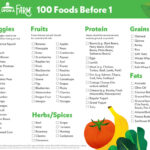Cooking large batches of your favorite dishes like soup, stew, or chili is a fantastic way to prepare for future meals. However, the way you cool and store these substantial quantities of food can be crucial in maintaining food safety and preventing the growth of harmful pathogens that can lead to foodborne illnesses. Understanding proper cooling and storage techniques is essential for ensuring that your delicious leftovers remain safe to eat.
Food safety guidelines from organizations like the United States Department of Agriculture (USDA) and Michigan State University Extension emphasize the importance of correct cooling and storage methods. The two-stage cooling method, widely used in commercial food service, is also highly effective for home use. This method focuses on rapidly reducing the temperature of hot food to minimize the time it spends in the “danger zone” where bacteria thrive.
To safely cool and store hot food in your refrigerator, follow these key steps:
-
Portioning is Key: Large volumes of hot food, such as soup, chili, or stew, should be divided into smaller portions and placed in shallow containers before refrigeration. This allows for quicker cooling.
-
Prepare Meat and Poultry: Large cuts of meat or whole poultry should be broken down into smaller pieces. Wrap them individually or place them in shallow containers to facilitate rapid cooling in the refrigerator. Shallow containers are crucial as they increase the surface area, allowing heat to dissipate faster.
-
Ice Bath Assistance: For even faster cooling, utilize an ice bath. Clean your kitchen sink and fill it with cold water and ice. Place the pot of food or the smaller containers into the ice water bath. Ensure that water from the sink does not contaminate the food. Stirring the food in the ice bath will further accelerate the cooling process.
-
Two-Stage Cooling Method: This method is critical for food safety. Hot food must be cooled from 140 degrees Fahrenheit to 70 degrees Fahrenheit within two hours, and then further cooled to 41 degrees Fahrenheit or lower within an additional four hours. This rapid cooling process is essential to move food quickly out of the danger zone. Use a food thermometer to accurately monitor the temperature during the cooling process.
-
Avoid Overloading the Fridge: Never place a large pot or container of hot food directly into the refrigerator or freezer while it is still steaming hot. The heat from the food can raise the internal temperature of your appliance, potentially compromising the safety of other stored foods and hindering the cooling of the hot food itself.
-
Indoor Cooling Only: Do not attempt to cool food outdoors. Outdoor temperatures are unpredictable and fluctuate, and food left outside is vulnerable to animals and environmental contaminants, increasing the risk of pathogen and bacteria exposure.
-
The Danger Zone: Always use a food thermometer to verify food temperatures and ensure food safety. Never leave food in the “Danger Zone” for more than two hours. The “Danger Zone,” defined as temperatures between 40 and 140 degrees Fahrenheit, is the temperature range in which bacteria multiply most rapidly. To keep food safe, maintain cold food at or below 40°F and hot food at or above 140°F.
By adhering to these straightforward guidelines, you can confidently ensure that your prepared food remains safe and enjoyable for you and your family. Proper cooling and storage techniques mean that leftover meals are not only convenient but also pose no risk of foodborne illness, allowing you to enjoy your cooking with peace of mind.


